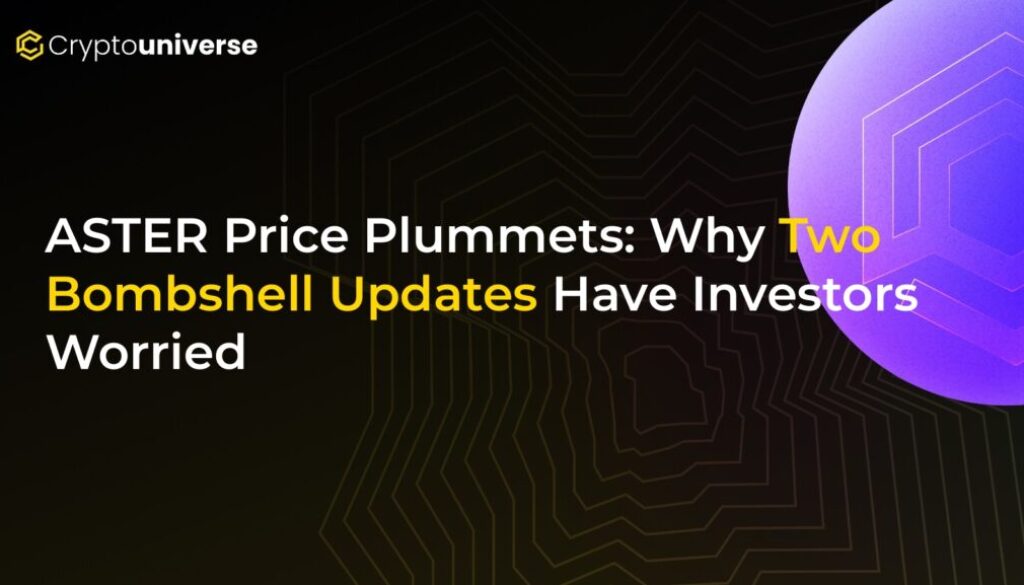ASTER Price Plummets: Why Two Bombshell Updates Have Investors Worried

ASTER Token Under Pressure Amidst Dual Controversies
The decentralized finance (DeFi) space is no stranger to volatility, but recent events surrounding the decentralized exchange (DEX) Aster have sent shockwaves through its community. The price of its native token, ASTER, has taken a significant hit, dropping by over 10% in a short period. This sharp decline isn’t a random market fluctuation; it’s a direct response to two major developments that have cast a shadow over the project’s credibility and short-term stability.
First, a bombshell from the trusted analytics platform DefiLlama, which announced it was delisting Aster’s trading volume data due to manipulation concerns. As if that wasn’t enough, the project’s own airdrop policy has sparked fears of a massive sell-off. Let’s break down these two critical issues and explore what they mean for the future of the ASTER price.
1. The DefiLlama Delisting: Allegations of Inflated Volume
For any DeFi project, data is king. Platforms like DefiLlama are crucial for providing transparent, verifiable metrics that investors use to gauge a project’s health and activity. That’s why their decision to remove Aster’s perpetuals trading volume was a major blow to investor confidence.
What Did DefiLlama Find?
According to DefiLlama builder 0xngmi, an investigation revealed that Aster’s trading volumes were suspiciously similar to those on Binance, one of the world’s largest centralized exchanges. The data for trading pairs like XRP/USDT and ETH/USDT mirrored Binance’s activity so closely that it raised red flags about the volume’s authenticity.
This practice, often referred to as wash trading, involves an entity simultaneously buying and selling the same asset to create a false impression of high trading activity. The goal is to climb the rankings on data aggregators, attract real users, and appear more successful than you are.
The core of the problem, as 0xngmi pointed out, was a lack of transparency from Aster.
“Aster doesn’t make it possible to get lower-level data such as who is making and filling orders,” he noted.
Without this granular data, it’s impossible to verify if the trading volume is organic. Citing a commitment to data integrity, DefiLlama chose to delist the data entirely rather than risk misleading its users.
A Divided Community
The community’s reaction was split. Some argued for a less severe measure, like keeping the data but adding a warning label. However, DefiLlama maintained that this would distort their aggregate metrics and compromise the reliability of their API for all users.
Interestingly, not everyone sees this as a negative. One tech commentator, TechLead, suggested a bullish interpretation: “If they’ve actually on-ramped Binance liquidity into DeFi, it’s a done deal.” This perspective frames the move not as manipulation, but as an innovative way to bring deep liquidity from centralized finance into the DeFi ecosystem. However, without confirmation from the Aster team, this remains speculation, and the dominant sentiment is one of suspicion.
2. The Airdrop Fallout: Bracing for a Supply Shock
While the DefiLlama news created a crisis of trust, Aster’s own airdrop announcement added a powerful catalyst for a potential price dump. The project revealed details for its Genesis Stage 2 rewards, and one specific detail has traders on high alert.
No Lock-Up, No Problem? The Market Disagrees.
Aster confirmed that the airdropped tokens, which become claimable on October 14, will have no vesting or locking period. This means recipients can sell their tokens on the open market immediately.
Here’s why that’s a big deal:
- Massive Supply Increase: The airdrop will release 4% of the total ASTER supply into circulation all at once.
- Sell Pressure: Airdrop recipients often sell their free tokens to realize profits, putting immense downward pressure on the price.
- Market Pre-emption: Savvy traders, anticipating this dump, may sell their own holdings beforehand to avoid losses, compounding the sell-off.
While Aster framed the decision as a move toward “fairness and flexibility,” the market interpreted it as a looming liquidity flood. Prominent crypto analyst Duo Nine predicted that the fallout could push the ASTER price down to the $1 mark, representing a nearly 50% drop from its current levels. He noted this could be a buying opportunity for those willing to brave the volatility.
A Perfect Storm of FUD
The combination of these two events has created a perfect storm of Fear, Uncertainty, and Doubt (FUD) around Aster. The wash trading allegations erode long-term trust in the platform’s fundamentals, while the unlocked airdrop presents a clear and present danger to its short-term price stability. The market’s reaction, a double-digit price drop, reflects this growing distrust.
For traders, the message is clear: the project’s transparency is in question at the exact moment a massive supply of tokens is about to hit the market. This scenario highlights a crucial lesson in DeFi: a project is only as strong as the community’s trust in its data and its tokenomics.
What’s Next for ASTER?
The path forward for Aster is challenging. The team must address the serious allegations from DefiLlama by providing verifiable, on-chain data to prove their volume is legitimate. Restoring trust with data aggregators and the wider community is paramount. Simultaneously, they will need to navigate the market’s reaction to the upcoming airdrop unlock.
The project’s ability to weather this storm will depend entirely on its commitment to transparency and its capacity to manage the immense selling pressure on the horizon. For now, investors are watching from the sidelines, waiting to see if Aster can turn innovation claims into verifiable reality.


